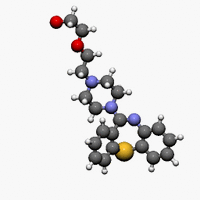Quetiapine
Quetiapine (/kwɨˈtaɪ.əpiːn/ kwi-ty-ə-peen) (branded as Seroquel, Xeroquel, Ketipinor) is a short-acting atypical antipsychotic approved for the treatment of schizophrenia, bipolar disorder, and along with an antidepressant to treat major depressive disorder.
Annual sales are approximately $5.7 billion worldwide, with $2.9 billion in the United States.[1] The U.S. patent,[2] which was set to expire in 2011, received a pediatric exclusivity extension which pushed its expiration to March 26, 2012.[3][4] The patent has already expired in Canada. Quetiapine was developed by AstraZeneca from 1992-1996 as an improvement from first generation antipsychotics. It was first approved by the FDA in 1997. There are now several generic versions of quetiapine, such as Quepin, Syquel and Ketipinor.[5]
Chemistry
Pharmocology
This means Quetiapine is a dopamine, serotonin, and adrenergic antagonist, and a potent antihistamine with clinically negligible anticholinergic properties.[6][7][8][9] Quetiapine binds strongly to serotonin receptors; the drug acts as partial agonist at 5-HT1A receptors.[10] In terms of its antipsychotic effects, the precise mechanism of action is unknown, but according to the dopamine theory of schizophrenia, antipsychotic effects might be related to the drug’s ability to reduce dopaminergic neurotransmission in the mesolimbic pathway.
Subjective effects
Physical effects
The physical effects of Quetiapine can be broken down into 3 components all of which progressively intensify proportional to dosage. These are described below and generally include:
Cognitive effects
The general head space of Quetiapine is often described as one of sedation, emptiness, apathy and zombification. The specific cognitive effects can be broken down into 7 components all of which progressively intensify proportional to dosage. These are described below and generally include:
- Thought deceleration
- Suppression of emotion
- Suppression of information processing
- Suppression of language
- Amnesia
- Ego suppression loss and death
- Suppression of anxiety
Toxicity and harm potential
Tolerance and addiction potential
Interactions
Legal issues
References
- ↑ http://drugpatentwatch.com/ultimate/preview/tradename/index.php?query=SEROQUEL
- ↑ http://patft.uspto.gov/netacgi/nph-Parser?Sect1=PTO2&Sect2=HITOFF&p=1&u=%2Fnetahtml%2FPTO%2Fsearch-bool.html&r=1&f=G&l=50&co1=AND&d=PTXT&s1=4,879,288.PN.&OS=PN/4,879,288&RS=PN/4,879,288
- ↑ http://patft.uspto.gov/netacgi/nph-Parser?Sect1=PTO2&Sect2=HITOFF&p=1&u=%2Fnetahtml%2FPTO%2Fsearch-bool.html&r=1&f=G&l=50&co1=AND&d=PTXT&s1=4,879,288.PN.&OS=PN/4,879,288&RS=PN/4,879,288
- ↑ Blockbuster Drugs That Will Go Generic Soon | http://money.usnews.com/money/blogs/the-best-life/2011/04/29/blockbuster-drugs-that-will-go-generic-soon
- ↑ http://www.theodora.com/drugs/quepin_tablets_specifar.html
- ↑ http://www1.astrazeneca-us.com/pi/Seroquel.pdf
- ↑ Binding of antipsychotic drugs to human brain receptors: Focus on newer generation compounds | http://www.sciencedirect.com/science/article/pii/S0024320500009115
- ↑ Neuropsychopharmocology, a fifth generation of progress | http://books.google.co.uk/books?id=BKwkonZwZD0C&pg=PA778&hl=en#v=onepage&q&f=false
- ↑ http://www.drugs.com/pro/seroquel.html
- ↑ Mechanism of Action of Quetiapine | http://psychopharmacologyinstitute.com/antipsychotics/quetiapine/mechanism-of-action/

